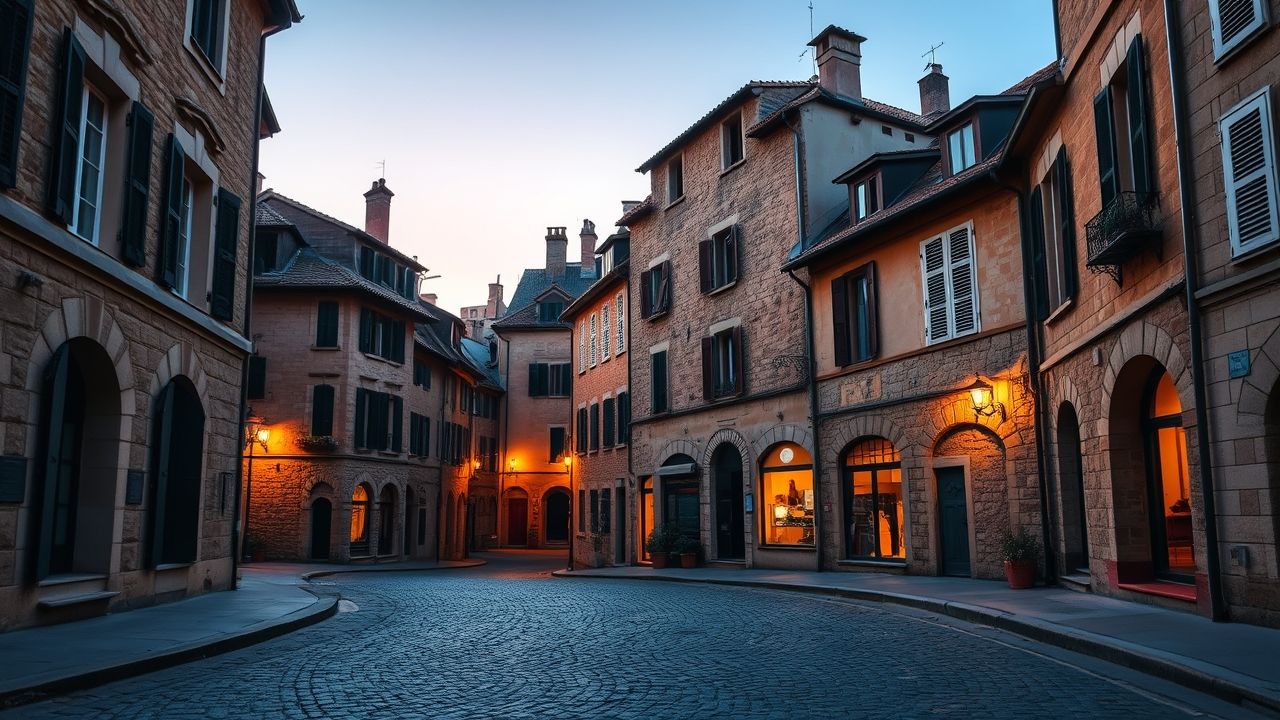Ah, Lyon. For many, it’s a quick stop on the TGV route, a picturesque blur between Paris and the South of France. But for those who truly know her, Lyon is not merely a city; she is a grand dame, a culinary legend, and a whisperer of centuries-old tales. As a seasoned traveler and a connoisseur of authentic experiences, I’ve always found myself drawn back to Lyon, discovering new layers with each visit. It’s a city that promises a feast for all senses, from the aroma of a simmering coq au vin to the intricate patterns of a Renaissance courtyard.
This isn’t just a travel guide; it’s an invitation to peel back the layers of Lyon, to understand its soul, and to experience it like a true insider. We’ll delve deep into its gastronomic heart, unravel its historical tapestry, and uncover the secret passages that only a few truly find. Prepare to discover why Lyon consistently ranks as one of France’s most compelling destinations.
Key Summary: Your Lyon Essentials
- Gastronomic Heaven: Lyon is the undisputed culinary capital of France, famed for its traditional bouchons and unique Lyonnaise cuisine.
- Historical Riches: Explore Roman ruins, a stunning Basilica, and the UNESCO-listed Renaissance architecture of Vieux Lyon.
- Secret Passageways: Discover the hidden traboules, an intricate network of shortcuts through buildings.
- Silk City Legacy: Learn about Lyon’s pivotal role in the European silk industry, particularly in the Croix-Rousse district.
- Cultural Vibrancy: Experience world-class museums, vibrant markets, and the spectacular Fête des Lumières.
Why Lyon Matters: More Than Just a Stopover
In my 15 years traveling France, I’ve realized Lyon isn’t just a city; it’s a living museum, a vibrant economic hub, and a cultural powerhouse that often gets overshadowed by the glitz of Paris or the allure of the Riviera. But Lyon stands on its own, with a history stretching back to Roman times, when it was known as Lugdunum and served as the capital of Gaul. This deep historical foundation permeates every cobbled street and ancient edifice, offering a tangible link to millennia past.
Beyond its historical significance, Lyon holds an undeniable gravitas as the gastronomic capital. This isn’t a self-proclaimed title; it’s a legacy forged over centuries, championed by culinary giants like Paul Bocuse. The city’s location, nestled between agricultural regions, ensures a constant supply of fresh, high-quality ingredients, fostering a culinary tradition unlike any other. It’s a place where food isn’t just sustenance; it’s an art form, a communal experience, and a profound expression of Lyonnaise identity.
Furthermore, Lyon’s strategic position at the confluence of the Rhône and Saône rivers made it a crucial center for trade and industry, particularly in silk production. This industrial heritage is still palpable, especially in the Croix-Rousse district, adding another fascinating layer to its complex identity. Lyon is a city that thrives on its past while embracing its future, making it an endlessly rewarding destination for the curious traveler.
Core Strategies for Experiencing Lyon
Embrace the Gastronomy: The Heart of Lyonnaise Life
To visit Lyon without diving headfirst into its culinary scene would be an unforgivable oversight. This is where the city truly reveals its soul. The cornerstone of Lyonnaise gastronomy is the bouchon – a traditional restaurant serving hearty, authentic Lyonnaise cuisine. These aren’t fancy Michelin-starred establishments (though Lyon has plenty of those too); they are cozy, often boisterous eateries known for their convivial atmosphere and generous portions.
What to try: Prepare for rich, comforting dishes. Must-tries include quenelles de brochet (pike dumplings), saucisson de Lyon (a local sausage), tablier de sapeur (breaded tripe), and the famous salade Lyonnaise (frisée lettuce with bacon, croutons, and a poached egg). Don’t forget the local cheeses like Saint-Marcellin and a glass of Beaujolais or Côtes du Rhône wine. And for dessert, the vibrant pink Tarte à la Praline Rose is an iconic sweet treat.
Expert Tip: Not all “bouchons” are authentic. Look for the “Les Bouchons Lyonnais” label, an official certification that guarantees a true experience, or simply observe where the locals are eating. Avoid overly touristy spots near Place Bellecour. The best ones are often found tucked away in Vieux Lyon or the Presqu’île.
[[Discover the Rich History of French Gastronomy]]
Navigating History: From Roman Ruins to Renaissance Streets
Lyon’s history is wonderfully layered, and you can literally walk through centuries of it. Start your historical journey at the Fourvière Hill, home to the magnificent Basilique Notre-Dame de Fourvière, which offers breathtaking panoramic views of the city. Just below, you’ll find the remarkably preserved Roman theatres, testaments to Lugdunum’s grandeur. These ancient amphitheaters still host concerts today, offering a unique blend of past and present.
Descend into Vieux Lyon (Old Lyon), a UNESCO World Heritage site and one of the largest Renaissance districts in Europe. Its narrow, winding streets are a delight to explore, lined with centuries-old buildings. Pay attention to the intricate doorways and the occasional grand inner courtyards. This district is also where you’ll encounter the famous traboules, which we’ll discuss more in the advanced tactics section.
Cross the Saône River to the Presqu’île, the peninsula between the two rivers, which boasts elegant Haussmannian architecture, grand squares like Place Bellecour, and upscale shopping. Continue north to the Croix-Rousse district, perched atop another hill. This area was once the heart of Lyon’s silk industry, and its steep streets and unique multi-story buildings (designed for silk looms) tell a fascinating story of the “canuts” (silk workers).
Art and Culture: Beyond the Plate
While food might be Lyon’s most famous export, its cultural scene is equally vibrant. The Musée des Beaux-Arts de Lyon, housed in a magnificent former abbey, holds one of Europe’s most important art collections, spanning from antiquity to modern art. For a more contemporary experience, the Musée des Confluences at the tip of the Presqu’île is an architectural marvel housing exhibits on natural history, anthropology, and societies.
If your visit coincides with early December, you’re in for a magical treat: the Fête des Lumières (Festival of Lights). This annual event transforms the entire city into a breathtaking canvas of light installations and projections, drawing millions of visitors. It’s an unforgettable experience that showcases Lyon’s creative spirit.
Advanced Tactics & Expert Secrets for a Deeper Dive
Unveiling the Traboules: Lyon’s Secret Passageways
One of Lyon’s most unique features is its network of traboules – hidden passageways that cut through buildings, connecting streets or leading to inner courtyards. Originally used by silk workers to transport goods directly from workshops to the river, these shortcuts became vital during the French Resistance. Exploring them feels like stepping into a secret world.
How to find them: Many traboules are unmarked or have discreet entrances. Some are publicly accessible during the day (look for a small sign or an open door), while others are through residential buildings and require a certain etiquette (pass quickly and quietly). The most famous ones are in Vieux Lyon and Croix-Rousse. Ask a local or join a specialized walking tour to truly uncover their secrets.
My Personal Insight: Back when I was first exploring Lyon in the early 2000s, I discovered that the true magic of the traboules lies not just in their existence, but in the stories they hold. Each passage whispers tales of industrious canuts and courageous résistant. Don’t just walk through them; imagine the lives that unfolded within their hidden walls. It’s an immersive history lesson.
[[Your Guide to Exploring Europe’s Hidden Passageways]]
Timing Your Visit: When Lyon Truly Shines
While Lyon is beautiful year-round, timing your visit can significantly enhance your experience. Spring (April-May) and early autumn (September-October) offer pleasant weather, fewer crowds than summer, and vibrant outdoor markets. This is ideal for exploring on foot and enjoying al fresco dining.
If the Fête des Lumières is on your bucket list, plan your trip for early December. Be prepared for colder weather and significant crowds, but the spectacle is truly unparalleled. Summer (July-August) can be hot, and some smaller bouchons or shops might close for holidays, but the city still offers plenty to do, including riverside activities.
Beyond the Tourist Trail: Local Markets and Hidden Gems
To truly experience Lyon like a local, venture beyond the main tourist arteries. The Hall des Bouchers Paul Bocuse (Les Halles Paul Bocuse) is an indoor gourmet market where you can sample some of the finest regional produce, cheeses, charcuterie, and pastries. It’s a perfect spot for a gourmet lunch or to pick up delicious souvenirs.
Explore the smaller, less-known neighborhoods. The Guillotière district, for instance, offers a diverse culinary scene with international flavors. Take a leisurely stroll along the banks of the Rhône, particularly on a sunny afternoon, and join the locals enjoying the river. For a peaceful escape, the Parc de la Tête d’Or, one of France’s largest urban parks, boasts a botanical garden, a zoo, and a lake.
Common Mistakes to Avoid in Lyon
Even the most seasoned travelers can make missteps. Here are a few common pitfalls to avoid when visiting Lyon:
- Only Eating in Tourist Traps: Just because a restaurant is in Vieux Lyon doesn’t mean it’s an authentic bouchon. Do your research, look for the “Les Bouchons Lyonnais” label, or ask locals for recommendations.
- Ignoring Public Transport: Lyon has an excellent public transport system (metro, tram, bus, funicular). While walking is key, utilize the funicular to reach Fourvière Hill and save your legs, or the metro to get between districts efficiently.
- Not Booking Popular Bouchons: Especially on weekends or evenings, popular bouchons can fill up fast. If you have a specific place in mind, make a reservation in advance.
- Underestimating the Hills: Lyon is built on two major hills (Fourvière and Croix-Rousse). Wear comfortable walking shoes, and don’t hesitate to use the funicular or metro to conserve energy.
- Missing the Silk History: The story of the “canuts” and Lyon’s silk industry is deeply intertwined with the city’s identity. Visit the Maison des Canuts in Croix-Rousse or explore the workshops to truly appreciate this heritage.
Frequently Asked Questions
What is Lyon famous for?
Lyon is primarily famous as the gastronomic capital of France, renowned for its traditional Lyonnaise cuisine served in cozy “bouchons” and its high concentration of Michelin-starred restaurants. It’s also known for its rich history, including Roman ruins and Renaissance architecture in Vieux Lyon, and its annual Fête des Lumières (Festival of Lights).
How many days do you need in Lyon?
To experience Lyon comprehensively, a minimum of 3 to 4 full days is recommended. This allows enough time to explore the major districts (Vieux Lyon, Presqu’île, Croix-Rousse), indulge in the culinary scene, visit key museums and historical sites, and perhaps discover some hidden gems without feeling rushed.
What is a “bouchon” in Lyon?
A “bouchon” is a traditional Lyonnaise restaurant characterized by its convivial atmosphere, hearty portions of local specialties, and often, a shared dining experience. They typically serve classic Lyonnaise dishes like quenelles, saucisson de Lyon, and rich stews, accompanied by local wines.
Is Lyon walkable?
Yes, Lyon is highly walkable, especially within its distinct neighborhoods like Vieux Lyon and the Presqu’île. However, be prepared for some steep climbs when visiting Fourvière Hill or the Croix-Rousse district. The city also boasts an excellent public transport system (metro, tram, bus, funicular) to help navigate longer distances or challenging inclines.
When is the Fête des Lumières?
The Fête des Lumières (Festival of Lights) in Lyon typically takes place over four days, usually centered around December 8th. This date commemorates a traditional procession to the Basilica of Fourvière, with the entire city illuminated by spectacular light installations and projections.




